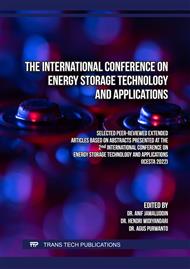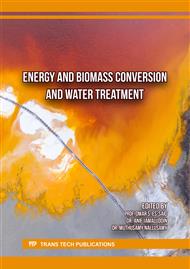[1]
Lv, Y., Cheng, X., Qiang, W., and Huang, B., 2020, Improved Electrochemical Performances of Ni-rich LiNi0.83Co0.12Mn0.05O2 by Mg-doping, J. Power Sources, 450 (January), 227718.
DOI: 10.1016/j.jpowsour.2020.227718
Google Scholar
[2]
Kwon, S. J., Lee, S. E., Lim, J. H., Choi, J., and Kim, J., 2018, Performance and Life Degradation Characteristics Analysis of NCM LIB for BESS, Electron., 7 (12), 1–19.
DOI: 10.3390/electronics7120406
Google Scholar
[3]
Ichlas, Z. T., Mubarok, M. Z., Magnalita, A., Vaughan, J., and Sugiarto, A. T., 2020, Processing mixed nickel‑cobalt hydroxide precipitate by sulfuric acid leaching followed by selective oxidative precipitation of cobalt and manganese, Hydrometallurgy, 191 (105185), 1–7.
DOI: 10.1016/j.hydromet.2019.105185
Google Scholar
[4]
Yudha, C. S., Rahmawati, M., Apriliyani, E., Nisa, S. S., and Jumari, A., 2022, Synthesis of Nickel Cobalt Manganese Ternary Transition Metal Oxide from Mixed Hydroxide Precipitate as a Precursor to NCM811, Defect Diffus. Forum, 417, 131–139.
DOI: 10.4028/p-483356
Google Scholar
[5]
Purwanto, A., Yudha, C. S., Ubaidillah, U., Widiyandari, H., and Ogi, T., 2018, NCA cathode material : synthesis methods and performance enhancement efforts NCA cathode material : synthesis methods and performance enhancement efforts, Mater. Res. Express, 5 (12), 122001.
DOI: 10.1088/2053-1591/aae167
Google Scholar
[6]
Purwanto, A., Yudha, C. S., Ubaidillah, U., Widiyandari, H., and Ogi, T., 2018, NCA Cathode Material : Synthesis Methods and Performance Enhancement Efforts, Mater. Res. Express, 5 (12), 1–22.
DOI: 10.1088/2053-1591/aae167
Google Scholar
[7]
Vaughan, J., Hawker, W., and White, D., 2011, Chemical aspects of mixed nickel-cobalt hydroxide precipitation and refining, Proc. ALTA Ni/Co/Cu Conf., (January), 23–25.
Google Scholar
[8]
Oh, H. J., Jo, C. H., Yoon, C. S., Yashiro, H., Kim, S. J., Passerini, S., Sun, Y. K., and Myung, S. T., 2016, Nickel oxalate dihydrate nanorods attached to reduced graphene oxide sheets as a high-capacity anode for rechargeable lithium batteries, NPG Asia Mater., 8 (5), e270-8.
DOI: 10.1038/am.2016.59
Google Scholar
[9]
Nisa, S. S., Rahmawati, M., Yudha, C. S., Nilasary, H., Nursukatmo, H., Oktaviano, H. S., Muzayanha, S. U., and Purwanto, A., 2022, Fast Approach to Obtain Layered Transition-Metal Cathode Material for Rechargeable Batteries, Batteries, 8 (1), .
DOI: 10.3390/batteries8010004
Google Scholar
[10]
Yudha, C. S., Hutama, A. P., Rahmawati, M., and Arinawati, M., 2022, cathode material for high capacity NCA / graphite secondary battery fabrication, 501–510.
DOI: 10.1515/eng-2022-0051
Google Scholar
[11]
Wu, K., Wang, F., Gao, L., Li, M. R., Xiao, L., Zhao, L., Hu, S., Wang, X., Xu, Z., and Wu, Q., 2012, Effect of precursor and synthesis temperature on the structural and electrochemical properties of Li(Ni 0.5Co 0.2Mn 0.3)O 2, Electrochim. Acta,.
DOI: 10.1016/j.electacta.2012.05.035
Google Scholar
[12]
Berckmans, G., Messagie, M., Smekens, J., Omar, N., Vanhaverbeke, L., and Mierlo, J. Van, 2017, Cost projection of state of the art lithium-ion batteries for electric vehicles up to 2030, Energies, 10 (9), .
DOI: 10.3390/en10091314
Google Scholar
[13]
Tran, M.-K., DaCosta, A., Mevawalla, A., Panchal, S., and Fowler, M., 2021, Comparative Study of Equivalent Circuit Models Performance in Four Common Lithium-Ion Batteries: LFP, NMC, LMO, NCA, Batteries, 7 (3), 51.
DOI: 10.3390/batteries7030051
Google Scholar
[14]
Masoumi, M., 2020, Thermochemical and electrochemical investigations of Li (Ni, Mn, Co) O $ _ {2} $(NMC) as positive electrode material for lithium-ion batteries, 2.
Google Scholar
[15]
Kanthachan, J., Khamman, O., Intatha, U., and Eitssayeam, S., 2021, Effect of reducing calcination processing on structural and electrochemical properties of LiNi0.5Mn0.3Co0.2O2cathode materials for lithium battery, Mater. Today Proc., 47 (xxxx), 3600–3603.
DOI: 10.1016/j.matpr.2021.03.691
Google Scholar
[16]
Murali, N., Babu, K. V., Babu, K. E., and Veeraiah, V., 2015, Synthesis and structural characterization of LiNi 0.92 Mg 0.08 O 2 and LiNi 0.92 Co 0.06 Mg 0.02 O 2 cathode materials, AIP Conf. Proc., 1665, 90–93.
DOI: 10.1063/1.4918266
Google Scholar
[17]
Kalyani, P., and Kalaiselvi, N., 2005, Various aspects of LiNiO2 chemistry: A review, Sci. Technol. Adv. Mater., 6 (6), 689–703.
Google Scholar
[18]
Purwanto, A., Yudha, C. S., Ikhwan Muhammad, K., Algifari, B. G., Widiyandari, H., and Sutopo, W., 2020, Synthesis of LiNi0.8Co0.15Al0.05O2 cathode material via flame-assisted spray pyrolysis method, Adv. Powder Technol., 31 (4), 1674–1681.
DOI: 10.1016/j.apt.2020.01.035
Google Scholar
[19]
Zhu, J., Yoo, K., Denduluri, A., Hou, W., Guo, J., and Kisailus, D., 2014, Crystal structure and size effects on the performance of Li[Ni1/3Co1/3Mn1/3]O2cathodes, J. Mater. Res., 30 (2), 286–294.
DOI: 10.1557/jmr.2014.370
Google Scholar
[20]
Yuan, X., Xin, H., Qin, X., Li, X., Liu, Y., and Guo, H., 2015, Self-assembly of SiO/reduced graphene oxide composite as high-performance anode materials for Li-ion batteries, Electrochim. Acta, 155, 251–256.
DOI: 10.1016/j.electacta.2014.12.124
Google Scholar
[21]
Hamad, K. I., and Xing, Y., 2019, Stabilizing Li-rich NMC materials by using precursor salts with acetate and nitrate anions for Li-ion batteries, Batteries, 5 (4), .
DOI: 10.3390/batteries5040069
Google Scholar
[22]
Yudha, C. S., Hutama, A. P., Rahmawati, M., and Arinawati, M., 2022, Production of nickel-rich LiNi0.89Co0.08Al0.03O2 cathode material for high capacity NCA / graphite secondary battery fabrication, Open Eng., 12, 501–510.
DOI: 10.1515/eng-2022-0051
Google Scholar
[23]
Yan, L., Liu, J., Wang, Q., Sun, M., Jiang, Z., Liang, C., Pan, F., and Lin, Z., 2017, In Situ Wrapping Si Nanoparticles with 2D Carbon Nanosheets as High-Areal-Capacity Anode for Lithium-Ion Batteries, ACS Appl. Mater. Interfaces, 9 (44), 38159–38164.
DOI: 10.1021/acsami.7b10873
Google Scholar
[24]
Li, B. Z., Wang, Y., Xue, L., Li, X. P., and Li, W. S., 2013, Acetylene black-embedded LiMn0.8Fe0.2PO4/C composite as cathode for lithium ion battery, J. Power Sources, 232, 12–16.
DOI: 10.1016/j.jpowsour.2013.01.019
Google Scholar
[25]
Xie, X., Hu, G., Cao, Y., Du, K., Gan, Z., Xu, L., Wang, Y., and Peng, Z., 2019, Rheological phase synthesis of Fe 2 P 2 O 7 /C composites as the precursor to fabricate high performance LiFePO 4 /C composites for lithium-ion batteries, Ceram. Int., 45 (9), 12331–12336.
DOI: 10.1016/j.ceramint.2019.03.149
Google Scholar
[26]
Abe, Y., Hori, N., and Kumagai, S., 2019, Electrochemical Impedance Spectroscopy on the, 1–14.
Google Scholar
[27]
Lapping, J. G., Borkiewicz, O. J., Wiaderek, K. M., Allen, J. L., Jow, T. R., and Cabana, J., 2020, Structural Changes and Reversibility upon Deintercalation of Li from LiCoPO4 Derivatives, ACS Appl. Mater. Interfaces, 12 (18), 20570–20578.
DOI: 10.1021/acsami.0c04110
Google Scholar
[28]
Jumari, A., Yudha, C. S., Widiyandari, H., and Lestari, A. P., 2020, SiO2/C Composite as a High Capacity Anode Material of LiNi0.8Co0.15Al0.05O2 Battery Derived from Coal Combustion Fly Ash, Appl. Sci., 10 (23), 1–13.
DOI: 10.3390/app10238428
Google Scholar



